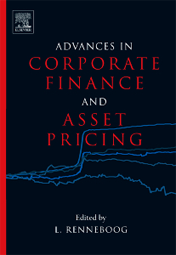Advances in Corporate Finance and Asset Pricing
<link portal page _blank>Abe de Jong, <link portal page _blank>Peter Roosenboom and <link portal page _blank>Gerard Mertens
 From a financial perspective, the past decade was remarkable. It is characterized by an unprecedented number of corporate restructurings in terms of mergers and acquisitions, initial public offerings, public-to-private transactions, spin-offs and divestitures, and leveraged recapitalizations. The first part of this book focuses on reorganizations from different perspectives: restructurings in Europe versus the US, short versus long term wealth effects of mergers and acquisitions, the international evidence of spin-offs and corporate focus strategies, and the consolidation in the banking world. In recent years, there have also been many changes in corporate governance regulation, triggered by a host of corporate scandals. Part 2 of this book will cover these issues on the international and domestic levels. It also deals with the effectiveness of specific corporate governance devices like shareholder lock-in agreements and managerial stock options. In part 3, the focus is on the changes in and the determinants of capital structure. In particular, the authors discuss convertible debt issues, give a historical perspective of the evolution of capital structure and also give an explanation for the importance of the interbank loan market. Asset pricing and monetary economics is the topic of the last part of the book. Here, models to improve portfolio theories and interest rate structures are proposed, momentum in stock prices is analyzed and the reasons for the changes in the monetary policy of the central banks over the last 3 decades are examined.
From a financial perspective, the past decade was remarkable. It is characterized by an unprecedented number of corporate restructurings in terms of mergers and acquisitions, initial public offerings, public-to-private transactions, spin-offs and divestitures, and leveraged recapitalizations. The first part of this book focuses on reorganizations from different perspectives: restructurings in Europe versus the US, short versus long term wealth effects of mergers and acquisitions, the international evidence of spin-offs and corporate focus strategies, and the consolidation in the banking world. In recent years, there have also been many changes in corporate governance regulation, triggered by a host of corporate scandals. Part 2 of this book will cover these issues on the international and domestic levels. It also deals with the effectiveness of specific corporate governance devices like shareholder lock-in agreements and managerial stock options. In part 3, the focus is on the changes in and the determinants of capital structure. In particular, the authors discuss convertible debt issues, give a historical perspective of the evolution of capital structure and also give an explanation for the importance of the interbank loan market. Asset pricing and monetary economics is the topic of the last part of the book. Here, models to improve portfolio theories and interest rate structures are proposed, momentum in stock prices is analyzed and the reasons for the changes in the monetary policy of the central banks over the last 3 decades are examined.
Table of Content
1. Introduction (L. Renneboog)
Part 1: Corporate restructuring
2. Mergers and acquisitions in Europe (M. Martynova, L. Renneboog).
3. The performance of acquisitive companies in the US (K. Cools, M. v.d. Laar).
4. The announcement effects and long-run stock market performance of corporate spin-offs: The international evidence (C. veld, Y. Veld-Merkoulova).
5. The competitive challenge in banking (A Boot, A. Schmeits).
6. Consolidation of the European banking sector: Impact on innovation (H. Degryse, S. Ongena, M.F. Penas).
Part II: Corporate governance
7. Transatlantic corporate governance reform ( J. McCahery, A. Khachaturyan).
8. The role of self-regulation in corporate governance: evidence and implications from the Netherlands (A. de Jong, D. Dejong, G. Mertens, C. Wasley).
9. Shareholder lock-in contracts: Share price and trading volume effects at the lock-in expiry (P.P. Angenendt, M. Goergen, L. Renneboog).
10. The grant and exercise of stock options in IPO firms: Evidence from the Netherlands (T. v.d. Groot, G. Mertens, P. Roosenboom).
11. Institutions, corporate governance and firm performance (J. Grazell).
Part III: Capital structure and valuation
12. Why do companies issue convertible bonds? A review of the theory and empirical evidence (I. Loncarski, J. ter Horst, C. Veld).
13. The financing of Dutch firms: a historical perspective (A. de Jong, A. Röell).
14. Corporate financing in the Netherlands (R. Kabir).
15. Syndicated loans: Developments, characteristics and benefits (G. van Roij).
16. The bank's choice of financing and the correlation structure of loan returns: loans sales versus equity (V. Ioannidou, Y. Pierides).
17 Shareholder value and growth in sales and earnings (L. Soenen).
Part IV: Asset pricing and monetary economics
18. The term structure of interest rates: An overview (P. de Goeii).
19. Incorporating estimation risk in portfolio choice (F. de Roon, J. ter Horst, B. Werker).
20. A risk measure for retail investment products (T. Nijman, B. Werker).
21. Understanding and exploiting momentum in stock returns( J.C. Rodriguez, A. Sbuelz).
22. Relating risks to asset types: A new challenge for central banks (J. Sijben).


